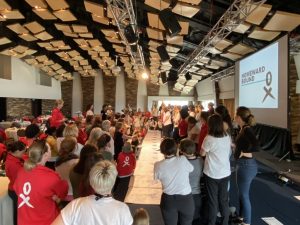Blog: What does it mean to be the Lead Facilitator for Homeward Bound?
In the beginning of 2018, I was selected to be a participant in the second cohort of the Homeward Bound (HB) leadership initiative (see here for previous post on HB and why it involves going to Antarctica). Although I knew I had learned lessons and gained a new global network of incredible women that would remain with me long after the journey was over, I certainly did not expect to return to Antarctica with the program again. However, one of the strengths of HB is the way it actively engages its alumnae in the ongoing development of the initiative and in 2019, I was offered the role of Lead Facilitator for the voyage of the fourth cohort. This meant that within a very short space of time, I went from being a participant just soaking up the learning experience, to someone with a key leadership role in facilitating the experience for others.
But what exactly does the role of Lead Facilitator entail?
In this post I want to outline what I had to do as a Lead Facilitator for Homeward Bound and the skills necessary to do the job. Hopefully this will help people see that my trip to Antarctica was certainly NOT a holiday!

Key Elements of the Lead Facilitator Role
Being the Lead Facilitator for Homeward Bound is a multidimensional role that involves several layers of responsibility. It was not a role that existed in the first two Homeward Bound voyages so it had only been performed once before – by Dr. Deborah O’Connell (HB1 alumna) – and it was not something I saw modeled during my time as a participant. Although every person who performs the role will inevitably approach it slightly differently (depending on their own skill set, the constellation of the cohort and group dynamics), the following are what I experienced as the main elements of the role.
- Be the daily face of HB for the participants
The Homeward Bound leadership training is delivered by a team of faculty members (12 were present on my voyage to Antarctica) but the Lead Facilitator plays an important role as the one person that is there every day. The person who greets them in the morning and releases them at night. The person who the participants can come to as their touchstone if they want to know about or contribute to what is going on. The person who has the overview of what is happening in the program as a whole. As such, the Lead Facilitator serves as the red thread running through the whole on board experience; the consistent daily face of HB.
- Manage relationships within and between the various groups involved in the voyage
In addition to being the key connecting bridge between the participants and the on board program, the Lead Facilitator is also responsible for facilitating the interactions between the faculty members as a team. This means organising, designing and chairing faculty meetings to ensure group cohesiveness and team satisfaction, as well as overarching agreements on things like objectives, content, and responses to participants concerns and questions. Furthermore, the Lead Facilitator also has to manage the relationship between the expedition staff of the vessel and HB. This includes liaising with the Expedition Leader regarding the possibilities for the daily landings (based on weather conditions, availability etc) and any inclusion of expedition staff and their educational content in the program.
- Coordinate the daily schedule
Through navigating all these different relationships, the Lead Facilitator has to craft the daily schedule of activities. In the first instance, this includes weaving together a maximum of 4.5 hours of leadership training content with a landing onshore (or alternatively a zodiac cruise). However, in practice, this scheduling also has to create space for additional and optional ‘deep dive’ workshops/conversations with the faculty and allow time for participants to run their own activities. Importantly, it also has to ensure that there is sufficient time for everyone to rest and process all the material. Of course, all of this scheduling also has to be in coordination with the kitchen onboard the ship and their delivery of three meals a day and snacks during break times. And all of this scheduling has to be able to respond to the constantly changing weather and ice conditions of Antarctica. It was not uncommon, for example, to decide upon and post the next days schedule during dinner, only to receive a phone call from the Expedition Leader before breakfast saying that conditions had changed and the day had to be completely re-planned.
- Read and respond to the energies of the group
As with any facilitation role, it is important to be able to read and respond to the group dynamic and mood. You need to be able to understand how the group you are working with is feeling and what they may need to stay on track in any given moment. This means being able to sense when your group is losing focus, becoming tired, frustrated, angry, or unclear about what is going on and then respond in a way that allows them to get what they need and reconnect with the experience. The Lead Facilitator has the power to significantly impact and set the tone of the day/session. This makes tuning in to the general atmosphere and needs of the group and then acting accordingly a crucial part of the role.
- Role model collaborative, inclusive and legacy-minded leadership
While being the consistent face of the initiative and communicating the daily program, the Lead Facilitator has also of course to role model the collaborative, inclusive and legacy-minded style of leadership that HB seeks to impart. It is a vitally important part of the role of Lead Facilitator that you can demonstrate to the participants the power, value and possibilities associated with this style of leadership.
The Skills Necessary for the Role

In the first instance, a Lead Facilitator for Homeward Bound has to be comfortable with public speaking in front of a large group of truly exceptional people. I have been speaking at international conferences, workshops, seminars and expert groups for years now so I am well trained in this particular skill. I am, however, also someone who happens to enjoy public speaking and feel that it comes more easily to me than it does to many others.
However a good Lead Facilitator cannot just be skilled in public speaking. They also need to be able to make connections between different contributions or perspectives and create transitions (as seamlessly as possible) from one event, activity or mood to another. This type of work cannot be prepared or practiced in advance because it requires an ability to think and articulate thoughts on the fly. It also helps if the Lead Facilitator has an interest in and eye for interconnections and overarching patterns, as well as a sensitivity for and ability to influence the mood of a group. I believe my experience working as both a transdisciplinary scholar and a yoga teacher helped prepare me for these aspects of the role.
I have been facilitating multi-disciplinary and multi-stakeholder interactions with people from multi-cultural backgrounds for many years now. This was an important part of my work as a transdisciplinary Research Leader and Professor of Environmental Governance, running international projects at the interface between science, ethics and politics. The skills I developed are also relevant as I work to bridge scientific, user and policy communities in my current position with NAMMCO. What is required for this type of work is an ability to make a diverse group of people feel comfortable, engage in conversation, share insights, unearth disagreements in a non-combative manner, find common ground, support one another and work towards collectively defined goals. To do this, I have always found it valuable to be creative and experiment with new ways and interactive forms of encouraging dialogue and facilitating learning. This willingness to try new approaches, exercises and activities was not only important for the Lead Facilitator role, it is also a key element of how HB works.
My experience as a yoga and meditation teacher also proved to be particularly valuable training for the position. Not only did I have the knowledge I needed to instruct the “5 minutes of mindfulness” or “Check-in” that was the opening session of every HB day, my yoga and meditation teaching has also heightened my sensitivity to how I can use my own voice and attitude to elevate or settle the energy of a group.
In addition to some of the strengths I brought into the position, there were also some really important skills that I had to hone and enhance underway. These included the ability to manage diverse interests, needs and personalities when building an effective and well-functioning team; the ability to both make concrete plans and remain flexible enough to adapt them at any time and as soon as the need arises, and; the ability to balance being inclusive and hearing all voices with taking the decisions that are necessary.
Key Lessons Learned
The role of Lead Facilitator is a demanding one and next year I pass the baton to Kate MacMaster (HB1 alumna) to serve in the role for HB5. Rotating the position is not only a strategy against burnout for Homeward Bound faculty who all voluntarily give their time to the initiative, it also creates space for others to participate and bring their unique experience and skill sets to the table.
Some of the key lessons from my experience this year that I would like to pass on for the future include:
- If you make a mistake or act in a way you are not proud of (towards faculty, participants or expedition staff), admit it, apologise for it, learn from it and move on – as quickly as possible!
- Surrender your frustration when things do not go as planned (because this will happen!) and work to accept the new situation as your reality and move into a forward looking, solution-oriented mindset – as quickly as possible!
- Canvas a range of alternatives before taking decisions that feel important but do not drown in the endless choices – explore the various options/viewpoints available and then take a decision.
- Trust your team, learn from them, be loyal to them and always want the best for them. You are stronger together!
- Know that you will never be able to please everyone at all times and find a way to be okay with that.
- Learning is a life-long process, change is inevitable, and collaborative forms of leadership provide powerful pathways forward into our uncertain future.
In my next post I will provide some more specific detail about some of the activities and exercises I ran on board.
By Fern Wickson


